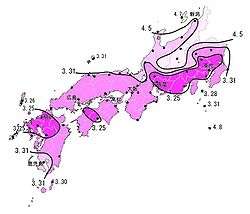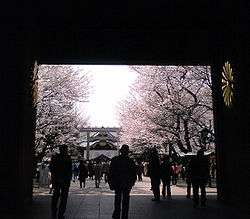Cherry blossom front
The cherry blossom front (桜前線, sakura zensen) refers to the advance of the cherry blossoms across Japan. The Japan Meteorological Agency records the opening and full bloom of the blossoms from Kyūshū in late March to Hokkaidō in the middle of May. The advancing front is also the subject of regular reports by the major news agencies. The cherry blossom is of great public interest in Japan thanks to its symbolism and the custom of flower viewing known as hanami.

Forecasts
From 1951 the Japan Meteorological Agency produced forecasts for the Kantō region and from 1955 for the whole of Japan excepting Okinawa and the Amami Islands.[1] From 2010, the Agency left forecasting to the private sector although it continues to observe and determine the impact of the climate upon the flowering of the cherry.[2][3] The forecast is based on the Arrhenius equation, with the formula
where T is the mean day temperature in kelvins, and DTS represents the number of days transformed to standard temperature.[4][5][6]
Blossoming
The day of opening[note 1] is defined as the point at which at least five to six flowers have opened on the sample tree. The day of full bloom is when at least 80% of the flowers have opened. The Yoshino cherry is typically observed since, from the late Edo period, it has been planted across the archipelago.[7] Sample trees also include the Higan cherry in the south and Prunus sargentii (Sargent's cherry) in the north.[7]
In 2006 it was reported that the cherry blossoms might overtake the plum blossoms before reaching Hokkaidō.[8]
Sample trees
There are fifty-nine sample trees at any one time. Successor junior trees are selected from among prospective candidates when an incumbent becomes too old or is otherwise incapacitated.[3] For instance, the sample tree in Mito collapsed under the weight of snow in 2005, while that at the southern tip of Ishigaki Island was felled by a typhoon a year later.[3] The fifty-nine sample trees are located across Japan, corresponding to the sites of the Agency's principal weather stations:[10][11][12]
- Okinawa: Ishigaki, Miyako-jima, Naha, Minamidaitō
- Kyūshū/Yamaguchi: Fukuoka, Shimonoseki, Ōita, Nagasaki, Saga, Kumamoto, Miyazaki, Kagoshima, Amami (formerly Naze)
- Shikoku: Takamatsu, Tokushima, Matsuyama, Kōchi
- Chūgoku: Hiroshima, Okayama, Matsue, Tottori
- Kinki: Ōsaka, Hikone, Kyōto, Maizuru, Kobe, Nara, Wakayama
- Tōkai: Nagoya, Shizuoka, Gifu, Tsu
- Kantō: Tōkyō, Mito, Utsunomiya, Maebashi, Kumagaya, Chōshi, Yokohama, Nagano, Kōfu
- Hokuriku: Niigata, Toyama, Kanazawa, Fukui
- Tōhoku: Sendai, Aomori, Akita, Morioka, Yamagata, Fukushima
- Hokkaidō: Sapporo, Wakkanai, Asahikawa, Abashiri, Obihiro, Kushiro, Muroran, Hakodate.
See also
Notes
- Japanese terms: day of opening (開花日); day of full bloom (満開日); sample tree (標本木); cherry blossom forecast (さくらの開花予想)
References
- "新しいサクラの開花予想" (PDF). Japan Meteorological Agency. Archived from the original (PDF) on 6 January 2013. Retrieved 1 March 2012.
- "気象庁におけるさくらの開花予想の発表終了について" (PDF). Japan Meteorological Agency. 25 December 2009. Retrieved 1 March 2012.
- "桜の標本木、進む代替わり 老齢化で後進育成急ピッチ". Asahi Shimbun. 25 March 2011. Retrieved 1 March 2012.
- "さくら開花予想方法について". Japan Meteorological Agency. Archived from the original on 6 May 2012. Retrieved 1 March 2012.
- Aono Yasuyuki (1993). "Climatological Studies on Blooming of Cherry Tree (Prunus yedoensis) by Means of DTS Method". Bulletin of the University of Osaka Prefecture. Ser. B, Agriculture and life sciences (in Japanese and English). Osaka Prefecture University. 45: 155–92.
- Dass, Vidhya; Brennan, Elizabeth. "Predicting Peak Bloom Date of Cherry Blossoms: Finding an Optimal Heuristic". Virginia Tech. Archived from the original on 18 June 2013. Retrieved 9 March 2012.
- "さくらの開花日と満開日" (PDF). Japan Meteorological Agency. Retrieved 1 March 2012.
- Joyce, Colin (7 April 2006). "Cherries winning the blossom race". The Daily Telegraph. Retrieved 1 March 2012.
- "境内の桜(東京の開花標本木)開花状況の映像". Yasukuni Jinja. Archived from the original on 5 May 2012. Retrieved 1 March 2012.
- "Cherry blossoms 2012 - day of opening" (in Japanese). Japan Meteorological Agency. Archived from the original on 8 March 2012. Retrieved 1 March 2012.
- "Agency Weather Stations (気象台, 測候所)" (in Japanese). Japan Meteorological Agency. Retrieved 2 March 2012.
- "2009 revised forecast (Note 4. 気象台や測候所の定めた標本木)" (PDF) (in Japanese). Japan Meteorological Agency. Archived from the original (PDF) on 20 April 2012. Retrieved 2 March 2012.
External links
- (in Japanese) 2012 day of opening (JMA record)
- (in Japanese) 2012 day of full bloom (JMA record)
- (in Japanese) 2011 day of opening (JMA record)
- (in Japanese) 2011 day of full bloom (JMA record)
- (in Japanese) JMA flowering data, 1953-2010
